An Autumn Migration single day tour today, on the North Norfolk coast. It was a rather cool, grey and overcast start, but gradually brightened up through the morning, with some nice warm sunny spells developing, particularly out of the cooler NNW wind. There was a forecast for thunderstorms bubbling up during the day, but fortunately we didn’t see a sign of any.
With the prospect of winds off the continent today, we headed over to Wells Woods first thing to see if we could find any migrants freshly arrived. A quick look at the boating lake produced a few Little Grebes and Tufted Ducks. It was still rather cool and damp in the trees as we made our way in – we could hear Coal Tits and a Goldcrest in the pines, but the birches beyond were rather quiet. A Siskin flew over calling.
We cut back out onto the main track and here we found a small group of Long-tailed Tits feeding on the outer edge of the trees. There were a few Blue Tits and Great Tits too, and then a Lesser Whitethroat flew across the path ahead of us and landed in a small hawthorn. The Lesser Whitethroat disappeared deeper in, but then a Common Whitethroat appeared in the same bush before flying up into the branches of one of the birches where we watched it feeding.
While we were watching the whitethroats, we had lost track of the tit flock but as we cut across to the open area south of the track, we could hear the Long-tailed Tits again calling in a lone pine tree. As they flew out one by one, we could see there was nothing following them now, but then the Lesser Whitethroat appeared in the blackthorn behind us, along with a couple of Blackcaps and we had a good view of them all in the tops of the bushes.
There had been a few Redstarts in the bushes here in the last few days but there was no sign of them this morning as we walked on round – there seemed to have been more departures overnight than arrivals. We did get better views of a Common Whitethroat in the brambles and birches, showing off its bright rusty wing panel, and a couple of lovely lemon-yellow Willow Warblers, presumably on their way south from Scandinavia.

As it started to warm up, a couple of Red Kites appeared low over the pines, flexing their wings and twisting their tails as they circled. There were more hirundines up now too, with a large flock of House Martins hawking for insects over the trees. It won’t be long now before they leave to head south for the winter.
The sun was on the birches now, so we headed back to the south side of the Dell to see if we could find any flycatchers. When we got there, someone had just seen some in the trees but they had disappeared. We walked up and down through that side of the Dell a couple of times – there were lots of Chiffchaffs feeding actively in the trees now, but all we had was a brief glimpse of a Pied Flycatcher, which disappeared again before everyone could get onto it. We heard a Green Sandpiper call overhead at one point and the same or another Siskin flew over. A Water Rail squealed from deep in the reeds by the back of the boating lake.
We decided to check round the rest of the Dell, but it was all very quiet, so we cut back out to the main path on the far side. As we walked back on the main path, past the south side of the Dell again, we finally found the Spotted Flycatcher now. It eventually showed nicely, in one of the birches by the track and high up in one of the poplars by the lake the other side.
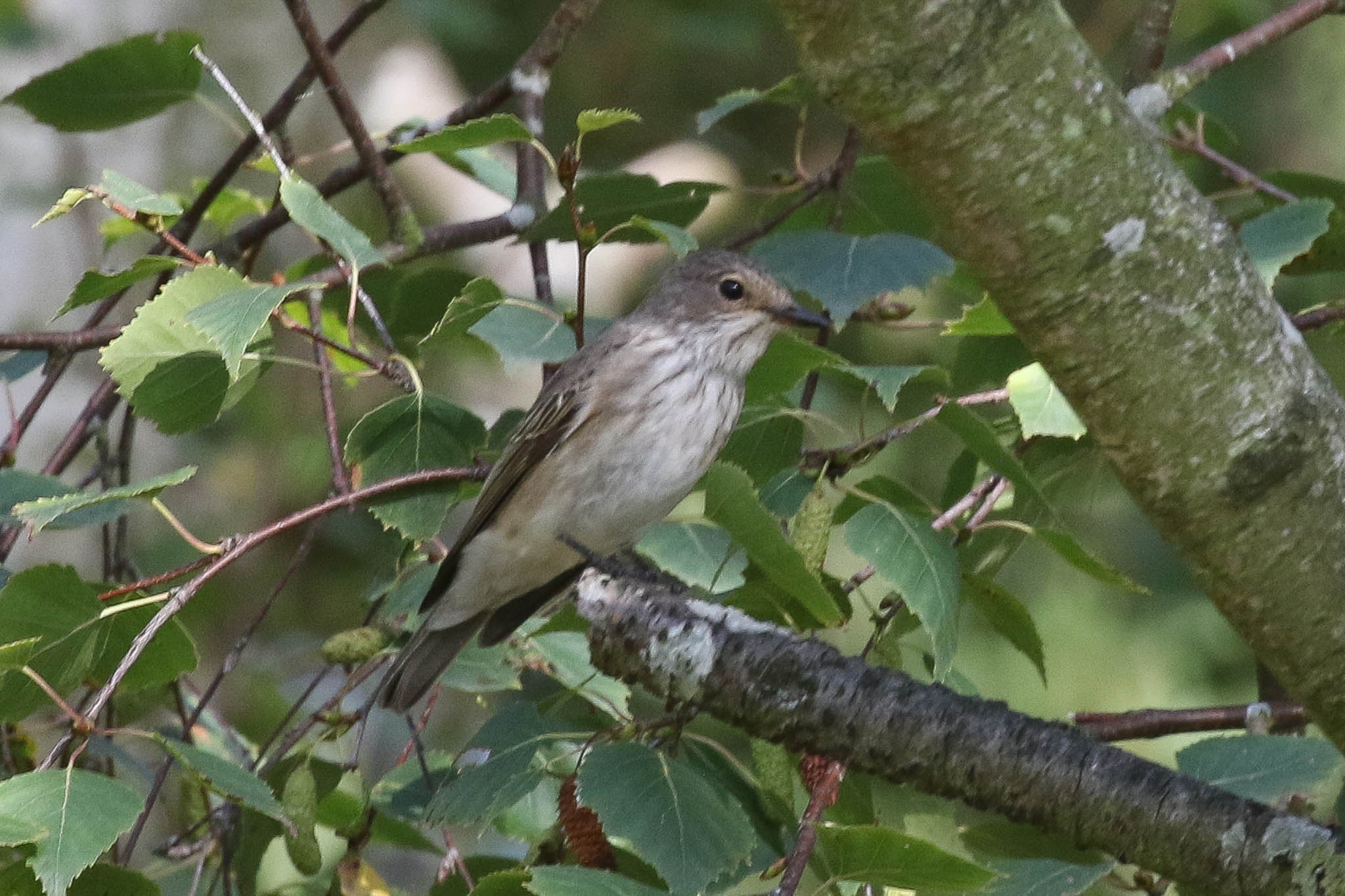
It was time to move on, so we made our way back to the minibus and had a short break for elevenses. It was gloriously sunny now and warm out of the wind here.
We made our way along the coast to Cley next. Having just had a bite to eat, we decided on a decent walk before lunch, so we parked at Walsey Hills and walked over to the East Bank. A Marsh Harrier was quartering distantly out over the reedbed. There had been a nice selection of waders along here in recent days but there were no reports of anything this morning, so we thought it might be a short stop. We were to be pleasantly surprised!
First we stopped at Don’s Pool to look for the Little Grebes – there was a pair on here with two tiny stripy-headed juveniles a couple of days before. We couldn’t see either of the adults at first but then noticed one of the youngsters out on the water on its own. After a while, one of the parents swam out of the reeds with something in its bill but the juvenile showed no interest in eating it, despite the adult trying to feed it repeatedly – presumably it was already full!
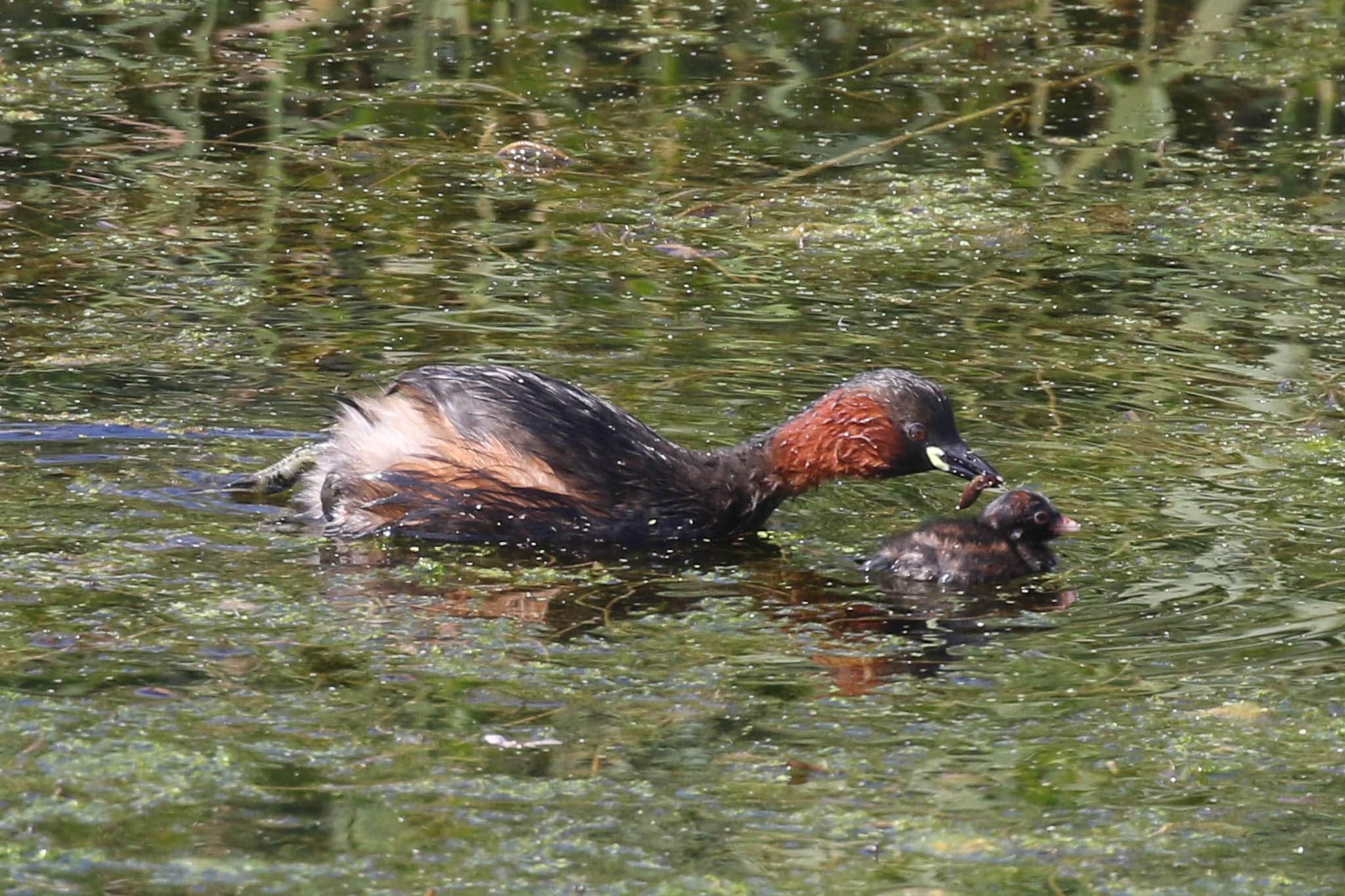
Eventually the adult Little Grebe gave up and resumed diving, leaving the juvenile on its own out on the water again. We didn’t see any sign of the second young one or the other parent. A Cetti’s Warbler was shouting from the reeds beyond.
Continuing on up the East Bank, we could see a lot of birds over the back of the grazing marsh around Pope’s Pool, so we stopped to get the scope on them. There were lots of ducks, plenty of Mallard and a few Gadwall loafing in the grass, moulting, and a few Wigeon in rusty eclipse plumage. Closer to, there were several Teal on the near end of the Serpentine. None of the ducks are looking their best at the moment, with the drakes all in eclipse. There were loads of Greylags and Canada Geese too.
Several Curlew and Lapwing were hiding in the grass too, and we could see four Avocets and a group of Black-tailed Godwits distantly out on Pope’s Pool. When we heard Sandwich Terns alarm calling out over Arnold’s Marsh, we looked across to see a juvenile Arctic Skua chasing them. It seemed to get bored pretty quickly, and broke off its pursuit, drifting away over the shingle ridge and back out to sea.
As if that wasn’t good enough, it was only when we walked on a little further that we really didn’t know which way to look! We got the scope first on a juvenile Little Ringed Plover which was feeding on the mud down at the front. While we were watching that, we picked up a single juvenile Curlew Sandpiper feeding further back, so we turned our attention to that next. At one point, we had it in the same view as a juvenile Dunlin giving a nice comparison, the Curlew Sandpiper slightly bigger with a longer, more downcurved bill, neatly scalloped above and cleaner white below.

Amazing to think that the Curlew Sandpiper had been raised just a few weeks ago right up in Central Siberia and is now migrating alone all the way down to Africa, the adults having departed earlier and left the young to make their own way!
We hadn’t finished looking at the Curlew Sandpiper when a small flock of Dunlin flew in and landed on the near edge of the water. Two smaller Little Stints flew in with them, so we turned our attention to those. We had some great views, at such close range – the Little Stints about two thirds the size of the Dunlin (which themselves are already small waders!). Through the scope, we could see their pale ‘braces’.
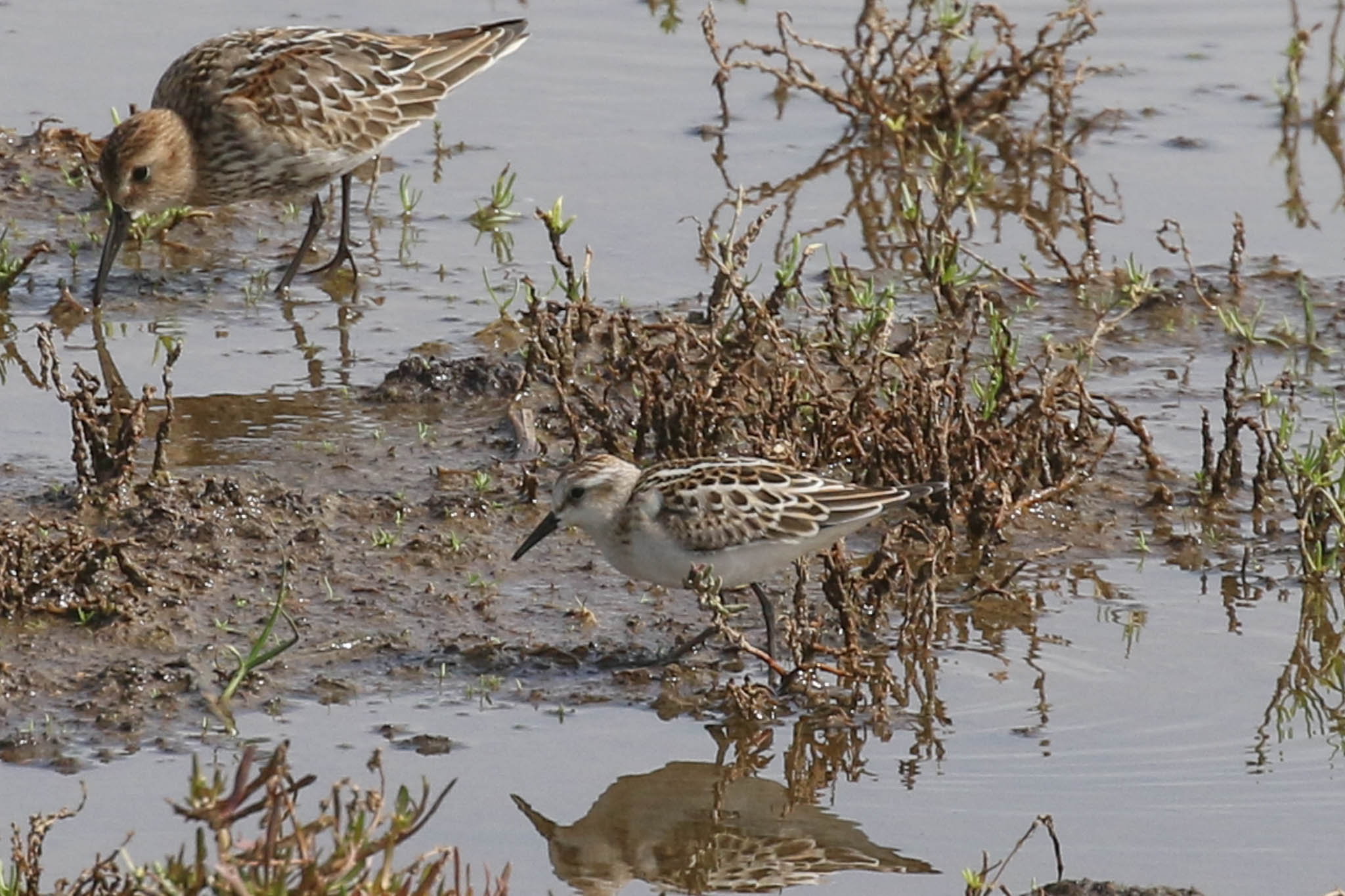
Then we heard a Spotted Redshank call a couple of times and after a quick scan we picked it up flying in. It flew across low over the Serpentine and we could see the cigar-shaped white patch on its back. It landed out of view on a small pool further back towards the road but thankfully didn’t like it there as the next thing we knew in flew in again and landed with some Black-tailed Godwits which were feeding across the other side of the water in front of us.
Now we got a proper look at it, a dusky grey juvenile Spotted Redshank. We could see its long, needle-fine bill and and white fore supercilium extending over the bill. When it eventually flew again, it landed further back on the Serpentine where it was joined by a second Spotted Redshank, this time a paler winter adult. We watched the two of them feeding in the deeper water, sweeping their bills from side to side as they walked.
A juvenile Ruff down on the mud at the front edge was almost overlooked in all the excitement. We had seen a Common Snipe in the wet grass by the godwits earlier and only now did we get a chance to get that in the scope for a closer look. An Avocet dropped in on the Serpentine too. The waders were all rather jumpy and when everything at the back spooked again, we looked over to see a young Sparrowhawk chasing round behind Arnold’s Marsh.
All the time we had been watching the waders, we could hear Bearded Tits calling on and off further up, in the reeds beyond the Serpentine. We had managed an occasional scan, but only now did we see one briefly, just as it was dropping back into the reeds out of view. We walked up to see if we could find it but it had disappeared in. It was a bit breezy here today, not ideal conditions for seeing Bearded Tits.
A Greenshank was calling from Arnold’s Marsh, but when we got up there, we couldn’t see it at first. There were lots of Common Redshanks and a few Curlew. There were no Sandwich Terns on here now, but two flew back in just as we arrived so we got the scope on one – we could see the yellow tip to its long black bill. Nearby, in with the loafing Black-headed Gulls, we picked out a winter adult Mediterranean Gull with its brighter red and more robust bill and black bandit mask. There was a 1st winter Mediterranean Gull hiding in there too and a Common Gull. Then we found the Greenshank in with them too.
With all the excitement out here, we had been longer than planned but after our earlier elevenses, no one was worried if we were a bit late back for lunch. So we continued on out to the beach for a quick look at the sea. There was a feeding frenzy of gulls and terns just offshore, and we picked up a juvenile Arctic Skua bobbing on the sea beyond, possibly the same one we had seen chasing the terns earlier. An adult Gannet was repeatedly plunge-diving around the gulls – very impressive to watch! A Guillemot flew past further out.
Then it really was time to head back for a late lunch at the Visitor Centre, with just a quick stop to watch a Little Egret on the brackish pool below the bank, struggling to subdue a fish it had caught.
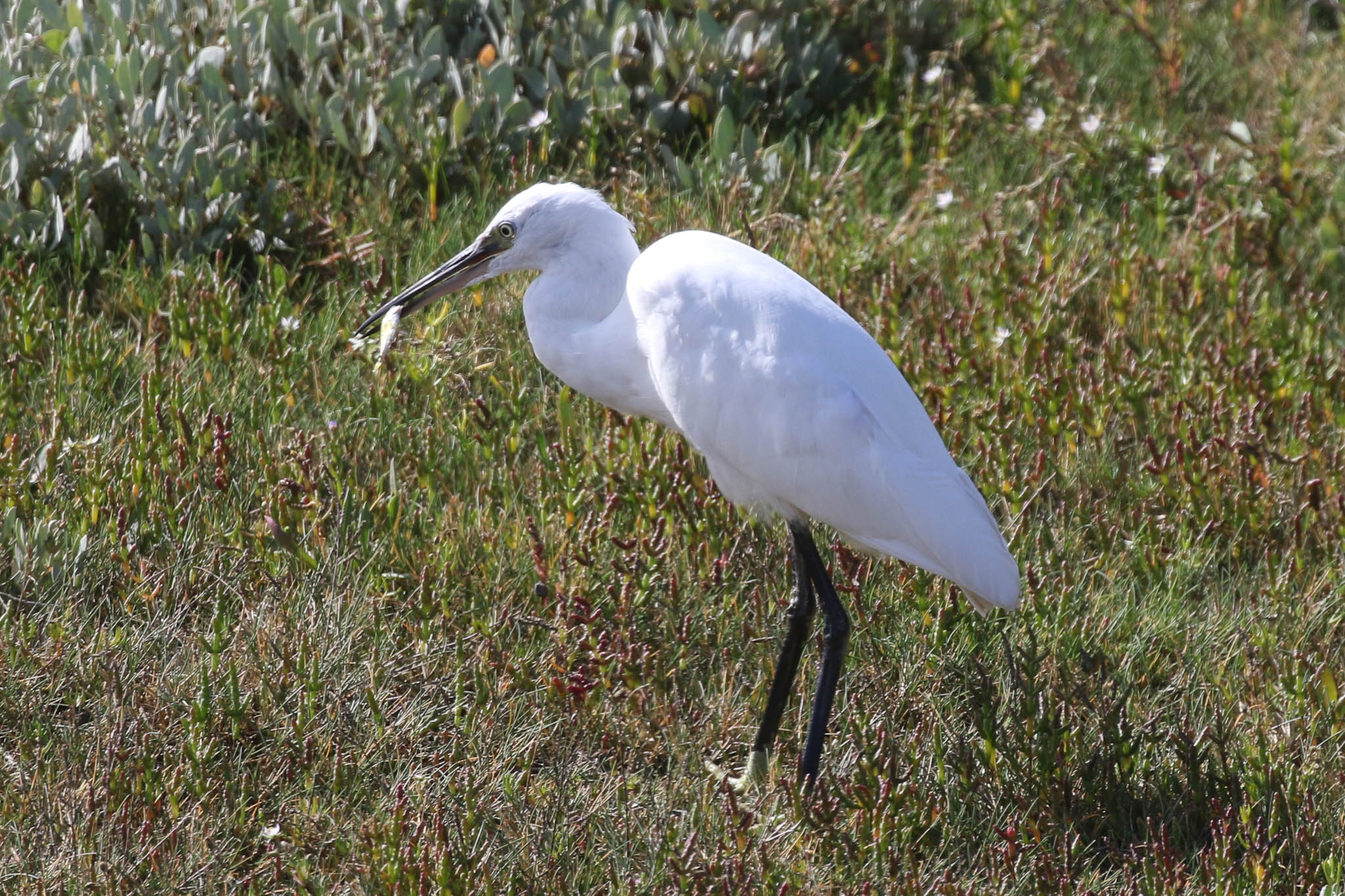
After lunch, we made our way east along the coast road to Kelling. There were some Goldfinches in the fir tree by the school and a couple of Chiffchaffs in the lane, but other wise the hedges along the lane were rather quiet this afternoon. We stopped briefly to look at some Ivy Bees buzzing around a big patch of ivy flowers and a little further on for a Migrant Hawker dragonfly which was patrolling up and down the track and stopped for a rest on the vegetation on the verge.

There were a few Teal, a couple of Moorhen and a Little Grebe on the Water Meadow pool and, as we rounded the corner, a family of Egyptian Geese on the grass on one side. A couple of Linnets were perched in the brambles over the far side and the grassy hillside beyond was liberally covered with the local Rooks. A Stock Dove flew over the Quags and dropped down onto the shingle behind the beach.
As we got down towards the bramble field, there were several Stonechats in the brambles along the fence line and dropping down into the short grass to feed. We stopped to watch them and then noticed that a couple of people further along had raised their cameras – presumably the Wryneck was showing. We walked quickly on to where they were standing and sure enough, the Wryneck was perched up on top of the brambles out in the field.
Before everyone could get onto it, the Wryneck dropped down out of view, but thankfully we didn’t have to wait too long before it appeared on top again. Now we could get it in the scope and admire its cryptically patterned plumage. Historically a regular breeder, Wrynecks are now no more than scarce visitors here, on their way between breeding grounds in Scandinavia and where they spend the winter in Africa. This one has been here over a week now, but went missing for a couple of days last week, so it can be elusive at times. We were lucky today!

Having seen the Wryneck without too long a wait, we decided to head on down towards the beach to see if we could find any Whinchats. As we walked up the hillside on the permissive path behind the beach, we looked back across the bramble field to see a Whinchat perched on the brambles on the far side, where the Stonechats had been earlier. Through the scope, we could see its bold pale supercilium and paler orange wash across the breast compared to the Stonechats.
There were lots of Goldfinches feeding on the thistles and teasel in the old sand pit behind the beach (where the owner of Weybourne Camp is now dumping builders’ waste where the orchids used to grow!) and a few Linnets with them. We stopped to scan and noticed a Wheatear running across the remaining area of short grass in the bottom. Before we could get the scope on it, it was flushed by a second Wheatear and the two of them flew back to the fence by the beach, flashing their white rumps.
There had obviously been a small fall of Wheatears here – there were at least another three on the track through the longer grass a little further along, including a smart autumn male with greyer back and more obvious black mask. Another Whinchat was perched on the fence behind them, along with a female Stonechat. As we walked up towards the gun emplacements, there were yet more Wheatears here, hopping around on the gravel tracks, perched on the concrete and one even at one point landing on one of the guns!
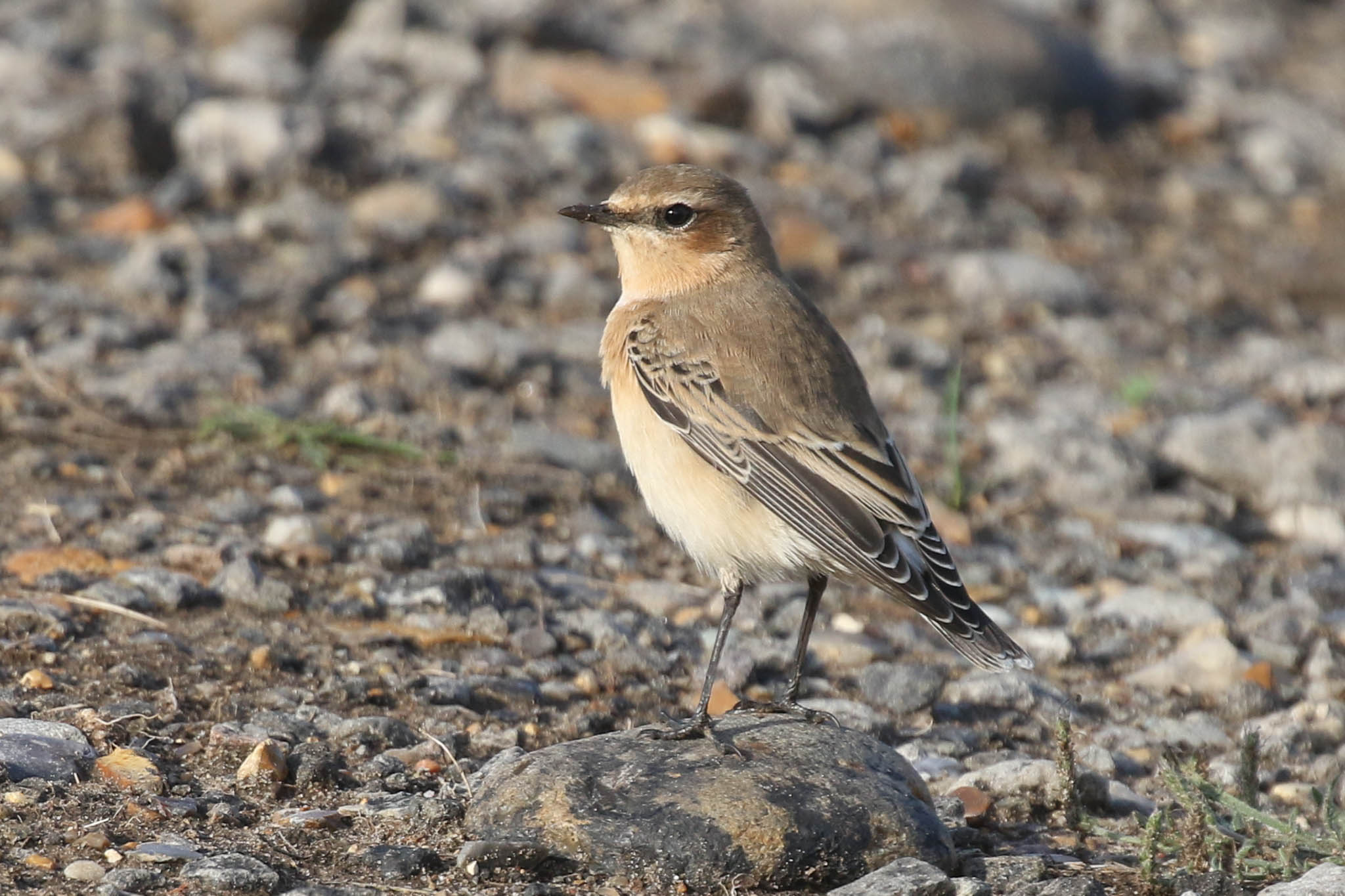
It was time to be heading back, but we hadn’t got far back down the hill before we noticed a message from further along the coast to say that three Long-tailed Skuas had just been seen flying east over Cley beach, heading our way. We decided to wait a little to see if they might come past. Three Bar-tailed Godwits flew high over the Camp behind us and disappeared off east.
It didn’t take us long to pick up a skua coming low over the sea but it was another juvenile Arctic Skua. There were several Sandwich Terns just offshore too, and the Arctic Skua diverted in to chase them briefly, hoping for a free meal, before continuing on east. Continuing to scan the sea to the west, after a few minutes we noticed another skua in the distance, off towards Gramborough Hill, coming straight towards us along the beach. It looked much more promising – noticeably smaller and daintier than the Arctic Skua we had seen earlier, and behaving very differently – but it kept disappearing down behind the shingle ridge out of view.
Before it got to the Hard, the skua came up over the top of the shingle and dropped down over our side, onto one of the big puddles at the base of the ridge. It was still some distance away, and we couldn’t see it because the fence was in the way, so we hurried further down to try to get the scope on it. Before we could get set up, a Black-headed Gull had a go at it and the skua was off again. As it flew up over the shingle ridge again, we could see it was a juvenile Long-tailed Skua.

It dropped down over the other side of the ridge once more, but then appeared along the top as it flew past us out over the beach and disappeared off east. Long-tailed Skua is the scarcest of the four skua species we get here, so this was a real bonus today. A perfect end to a very enjoyable day of autumn migrants. We paused briefly to look at some Red-legged Partridges and a Brown Hare in the stubble by the lane, as we made our way back to the minibus and then headed for home.
















